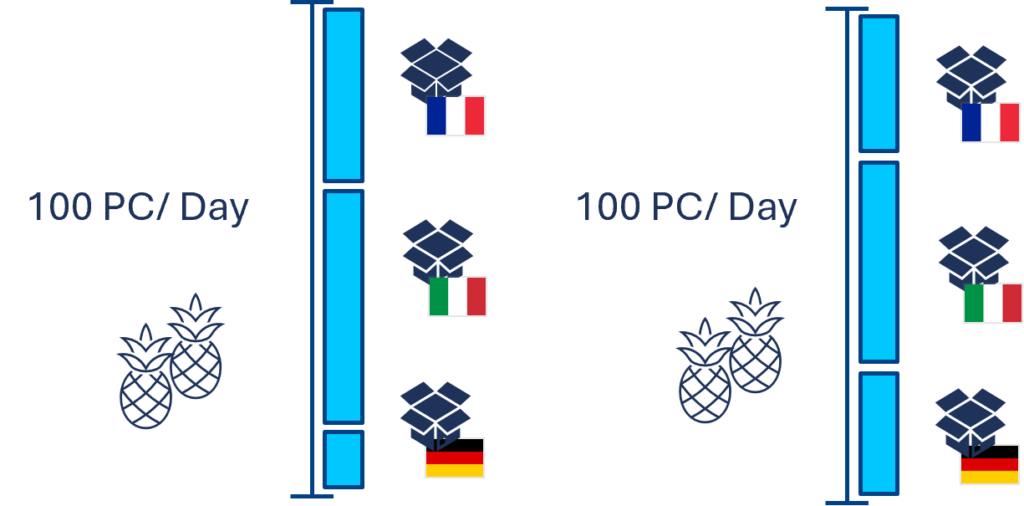
Risk & Resilience in Logistics Network Design
Reimagine resilience and proactively minimize supply chain risks

In production planning and detailed scheduling, production planners must navigate numerous requirements and constraints that need careful consideration. Every planner is familiar with the desire for more system support to manage the checks and repetitive rules that are part of daily production planning. The benefit of a production planning and scheduling tool that can accommodate your specific planning rules is clear: It frees up more time to tackle complex, unexpected, short-term challenges that cannot be solved by predefined rules.
In this article, we present three real-life examples — among many others — illustrating how the Campaign Planner can be configured to meet your unique planning needs. With the Campaign Planner & Designer, you can manage and apply all these rules simultaneously with ease. The topics covered include setting a minimum economic campaign size, prioritization strategies for capacity bottlenecks, and the Campaign Fill-Up feature, designed to maximize your capacity utilization.
In many industries, product groups — comprising multiple material numbers — serve as a key planning level. These campaigns typically involve products that may differ in packaging or labeling but essentially contain the same product or mixture. As a result, the specific material ID requested is less important than ensuring that the combined demand for these material IDs reaches a critical minimum campaign size, making it economical to produce a full bulk, mixture, or batch. In the Campaign Designer, you can define minimum campaign groups that consolidate these individual material IDs. Additionally, a minimum campaign size for the group is set. The campaign planning heuristic will only schedule the production in the next cycle if the total demand meets or exceeds the defined minimum. This prevents inefficient small campaigns or triggering a large batch production based on minimal demand for a single material ID.
The following example illustrates a vanilla milk campaign. While all material IDs represent the same vanilla milk, they are packaged in different bottle sizes such as 250ml and 400ml. Consequently, each finished product variant has a distinct material ID. To streamline production, we create a minimum campaign group for vanilla milk, assigning all related material IDs. For instance, if there is a demand for 1,000 units of 250ml bottles and 1,000 units of 400ml bottles — resulting in a total of 650 liters — it would be uneconomical to produce a full 50,000-liter batch in the next campaign cycle. In this case, the system would skip production. However, if the total demand across all vanilla milk bottles reaches 35,000 liters, a ‘make’ decision would be triggered. The vanilla milk campaign would then be scheduled for the next cycle.

In campaign planning, production is organized into cycles (e.g., every 7 days or 4 weeks), after which a new campaign starts on the resource. At the beginning of each cycle, the campaign planning heuristic (an automated planning process) determines which products to produce or skip, based on demand and predefined rules. In some cycles, demand may exceed available capacity, creating a bottleneck. When preproduction is no longer feasible, decisions must be made regarding which products to prioritize and which to reduce in quantity or defer to the next cycle.
The Campaign Planner allows you to define rules that specify which material IDs or product groups should be reduced or postponed when capacity is constrained. For example, consider Products A, B, and C: Product A has high margins and is critical for key customers, while Product C has lower margins. In a bottleneck situation, the campaign planning heuristic first reduces the quantity of Product C until the remaining orders fit within the available capacity. If this isn’t sufficient, Product C is deferred to the next cycle. The heuristic then reduces Product B’s quantity until all planned orders fit within the cycle’s capacity.
Additional Note: To ensure fair distribution of reductions across products and prevent Product C from being consistently postponed, you can configure rules that reduce all products or product groups equally during bottlenecks.

Another frequent challenge faced by production planners is manually adjusting campaign sizes to fill entire days, shifts, or weeks, as the standard planning run does not automatically increase quantities unless there is additional demand.
This issue is particularly relevant in production environments where large batches are produced within a single day, and resources for the next campaign group can only be cleaned overnight or over the weekends. A typical MRP (Material Requirements Planning) run generates orders based on demand and the established lot size settings for each material ID. However, campaign planning involves various combinations of material IDs that can all be produced within the same campaign group in a single day. This cannot be effectively managed solely through master data settings like fixed lot sizes for individual products, as the daily lot size for a group of products is independent of the lot size for each specific material ID.
In the fruit gum industry, you may have a common bulk material called “Tropical Fruit Mix” which needs to be packaged into three different bags for different countries, such as Italy, France, and Germany. Each features distinct language labels. The daily campaign size is set at 100,000 bags, but the distribution of bags among the countries is flexible. For instance, a daily campaign could yield 10,000 bags for Germany, 50,000 for Italy, and 40,000 for France, or it could result in 30,000 for Germany, 30,000 for France, and 40,000 for Italy.
If the combined demand for all three material IDs does not meet the target of 100,000 bags, the planner must manually adjust the lot sizes proportionally or for specific products to ensure the total equals the full daily requirement of 100,000 units.

The campaign planning heuristic can be configured to either proportionately increase the lot sizes of individual materials to achieve the overall daily campaign lot size across all products or to prioritize filling the day exclusively with high-demand products from the campaign group. This approach helps mitigate the risk of excessive inventory accumulation for less frequently sold products.

The business examples provided illustrate just a fraction of the numerous parameterization options available within the Campaign Planner & Designer. These examples highlight that the tool addresses not only economic lot size requirements based on campaigns but also effectively manages planned orders during bottleneck situations and optimizes capacity utilization.
Planners using the Campaign Planner & Designer benefit from its user-friendly interface and the ease with which new planning rules can be adopted. Moreover, the transparency provided by the Campaign Monitor allows for traceability of every planning step.
With the Campaign Planner & Designer, planners transition from repetitive manual tasks to a more streamlined approach involving parameterization, automation, and exception-based planning. This shift enables them to dedicate more time to complex issues that cannot be parameterized, while automation takes care of sequencing and maximizes capacity utilization.

Reimagine resilience and proactively minimize supply chain risks

This article shall help you to understand how to optimize your inventory positions in a month – or even less.

Modern PLM systems empower businesses to achieve product excellence in fast-paced markets by enhancing collaboration, agility and innovation.

Read how the Campaign Planner & Designer (CPD) helps you to manage supply chain variability.
© Camelot Management Consultants, Part of Accenture
Camelot Management Consultants is the brand name through which the member firms Camelot Management Consultants GmbH, Camelot ITLab GmbH and their local subsidiaries operate and deliver their services.